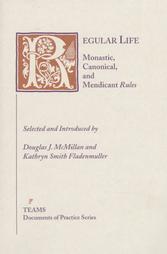
|
Posted November 4, 2004
Book: Regular Life: Monastic, Canonical, and Mendicant Rules Selected and Introduced by: Daniel Marcel La Corte and Douglas J. McMillan Medieval Institute Publications, Kalamazoo, Michigan, pp. 164 An Excerpt from the Preface:
The purpose of this book is to introduce the reader to the Rules of life of the major religious orders within the monastic, canonical, and mendicant traditions. We present the most important Rules of religious life, mainly as developed in western Europe, and we offer selections from these Rules and other documents to illustrate the ideals established for the members of various orders through the fourteenth century. . . . . . . . Monasteries are experiencing increased visitors and retreatants each year, welcoming people from all walks of life and religious backgrounds to experience something of the monastic life. Regular life was a major factor in the medieval and modern history, and has been the inspiration of creative writers from before Chaucer to the late twentieth century. A clue to its enduring fascination lies in this passage from the most famous and influential of the medieval Rules, that of St. Benedict: “Whoever you are, if you wish to follow the path to God, make use of this little Rule for beginners. Thus at length, you will come to the heights of doctrine and virtue under God’s guidance. Amen.” An Excerpt from the Book: From the Rule of St. Benedict Of Discretion How necessary discretion is for monks is shown by the mistake of many, and indicated by the downfall of some, wh beginning without discretion and passing their time without a sobering knowledge, have been unable to complete a praiseworthy life; since, just as error overtakes those who proceed without a path, so for those who live without discretion intemperance is at hand, and this is always the opposite of virtues which are place in the mean between each extreme. Its onset is a matter of danger, when beside the straight way of discretion our foes place the stumbling-blocks of wickedness and the offences of various mistakes. Therefore we must pray God continually that He would bestow the light of true discretion to illumine this way, surrounded on every side by the world’s thickest darkness, so that His true worshipers may be able to cross this darkness without error to Himself. . . . Thus between the little and the excessive there is a reasonable measure in the midst, which ever recalls us from every superfluity on either side, and in every case posited provides what is universally fixed by human need, and spurns the unreasonable demand of superfluous desire. And this measure of true discretion, weighing all our actions in the scales of justice, in no wise allows us to err from what is just, or to suffer a mistake, if we ever follow straight behind the leader. For while we must always restrain ourselves from either side, according to that saying, “Keep yourselves from the right and from the left (cf. Deut. 5:32). We must ever proceed straight forward by discretion, that is, by the light of God while very often we say an sing the victorious psalmist’s verse, “My God enlighten my darkness, since in Thee I am rescued from temptation. For temptation is the life of man on earth” )Ps. 18:29;Job 7:1) Table of Contents: Introduction Regular Life: historical background Rules for Eastern Orders of monks and nuns Rules for Western Orders of monks and nuns Reformed Orders of monks and nuns The call of the desert in the high middle ages: primitive monastic models Rules for Orders of canons and Canonese/nuns Rules for Orders of friars, nuns, and lay persons Conclusions The Rules The life of Antony The letters of St. Antony the Great The life and regimen of the Blessed and Holy Syncletica Pachomian Koinonia I: The first Sahidic life of Pachmius St. Basil: The long rules The Conferences of Cassian The Rule of Augustine St. Caesarius of Arles The rule of the master The rule of St. Benedict Rule for monks by Columbanus The rule of a certain father to the virgins The Carolingian Reform Benedict of Aniane, by Ardo The Cluniac Refore The foundation charter of the Order of Cluny, Sept. 11, 909 A.D. The twelfth-century monastic renewal The Carthusians The life of St. Gilbert The Cistercians: Early Cistercian documents The military orders: The Knights Templar and the Hospitallers The Knights Templar: The Primitive Rule The Hospitallers The Mendicants: Francis, Clare, and Dominic Introduction to St. Francis, The Rule of 1223 and The First Rule of the Third Order Introduction to St. Clare of Assisi, The Rule of St. Clare The Dominican Friars |
|
